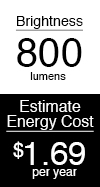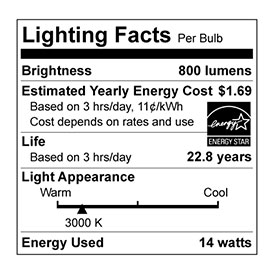New Light Bulb Packaging
Lighting Facts Labels:
Helping You Choose Bulbs with the Right Brightness
Lighting Facts Label
The Federal Trade Commission (FTC) recently passed a legislation to implement a new lighting facts label on light bulb packaging. The new lighting facts label will be included on all bulbs intended for general service purposes. Packaging for standard base LEDs, CFLs and your household incandescents will begin sporting this new two part label over the next few months leading up to the effective date for this new ruling of January 1st, 2012.
When it comes to buying light bulbs, the new lighting facts label will help you make faster, easier and smarter choices!
Just how will this label help me?
Just as a Nutrition Facts label can help you pick a low calorie cereal, the new Lighting Facts label will help you pick an energy efficient light bulb. With all of the new technology available in lighting, the label provides you with information regarding lamp brightness, the cost to operate the bulb, lamp life, color, and even tell you whether or not the bulb contains mercury.
Here's a quick and easy guide on how to read the Lighting Facts Label:

Front Label:
In a rush? The front of bulb packaging will tell you what you need to know.
- How bright is this lamp?
- How much will it cost to operate?
Brightness:
If you’re asking WATT lamp you need, you’re asking the wrong question. Wattage is not what you should be considering when trying to determine how bright you want your bulb. The brightness of a lamp is actually measured in LUMENS. Just remember, more lumens = more light.
Tip:
As a general rule of thumb, dividing the lumens by 10 will give you the estimated lamp wattage. For example, this label indicates the lamp has 820 lumens. Dividing this number by 10 results in 82, therefore this lamp consumes close to 82 watts or more commonly would probably replace a standard 75 watt lamp. The number which you divide by can range anywhere between 10-17 to get a good estimate, but 10 is a good place to start.
For more information regarding the FTC Lamp Labeling Rule:
Website:
www.ftc.gov/energy
Media contact:
Mitchell KatzOffice of Public Affairs
202-326-2161
202-326-2161
Staff contact:
Hampton NewsomeBureau of Consumer Protection
202-326-2889
202-326-2889
Side or Back Label:
Be sure to read through the full Lighting Facts label for the full scoop.

Life:
Based on 3 hours a day of use, the estimated life of the bulb is expressed in years.
Energy Used:
The wattage lets you know how much electricity is consumed. Energy efficient light sources typically have high lumens and low wattage.
More information:
Bulbs that contain mercury will include a disclosure as well as a website that describes how you should dispose of the lamp (epa.gov/cfl) and Energy Star qualifying products will have the Energy Star logo on the label.
By the way, if you are replacing a lamp, but didn’t keep the box, don’t worry! The new law requires manufacturers to put brightness directly on the bulb, so just unscrew it and take a look at the bulb itself.to get a good estimate, but 10 is a good place to start.
Estimated yearly energy cost:
This dollar amount will tell you how much it will cost to operate the bulb for one year, based on 3 hours a day of use and a rate of $0.11 per kWh (kilowatt per hour). A kWh is the amount of power consumed/generated over a period of one hour. When you buy electricity power companies will invoice you by the kilowatt-hour (kWh). Although the FTC requires this calculation to use a rate of $0.11 per kWh, electricity rates vary by region. Check with your power supply company to confirm the rates in your region.
Light appearance:
This easy to read scale will tell you whether the light has a warmer or cooler tone. A warm white light will have a marker on the left end of the scale and cool daylight will have a marker closer to the right.
Tip:
Lamps that have a higher rating on this scale are cooler in nature, resembling daylight, and often appear to be brighter when compared to a warm white bulb even if the lumens are the same.
